MERCEDES-BENZ C CLASS 2016 Owners Manual
Manufacturer: MERCEDES-BENZ, Model Year: 2016, Model line: C CLASS, Model: MERCEDES-BENZ C CLASS 2016Pages: 398, PDF Size: 11.64 MB
Page 221 of 398
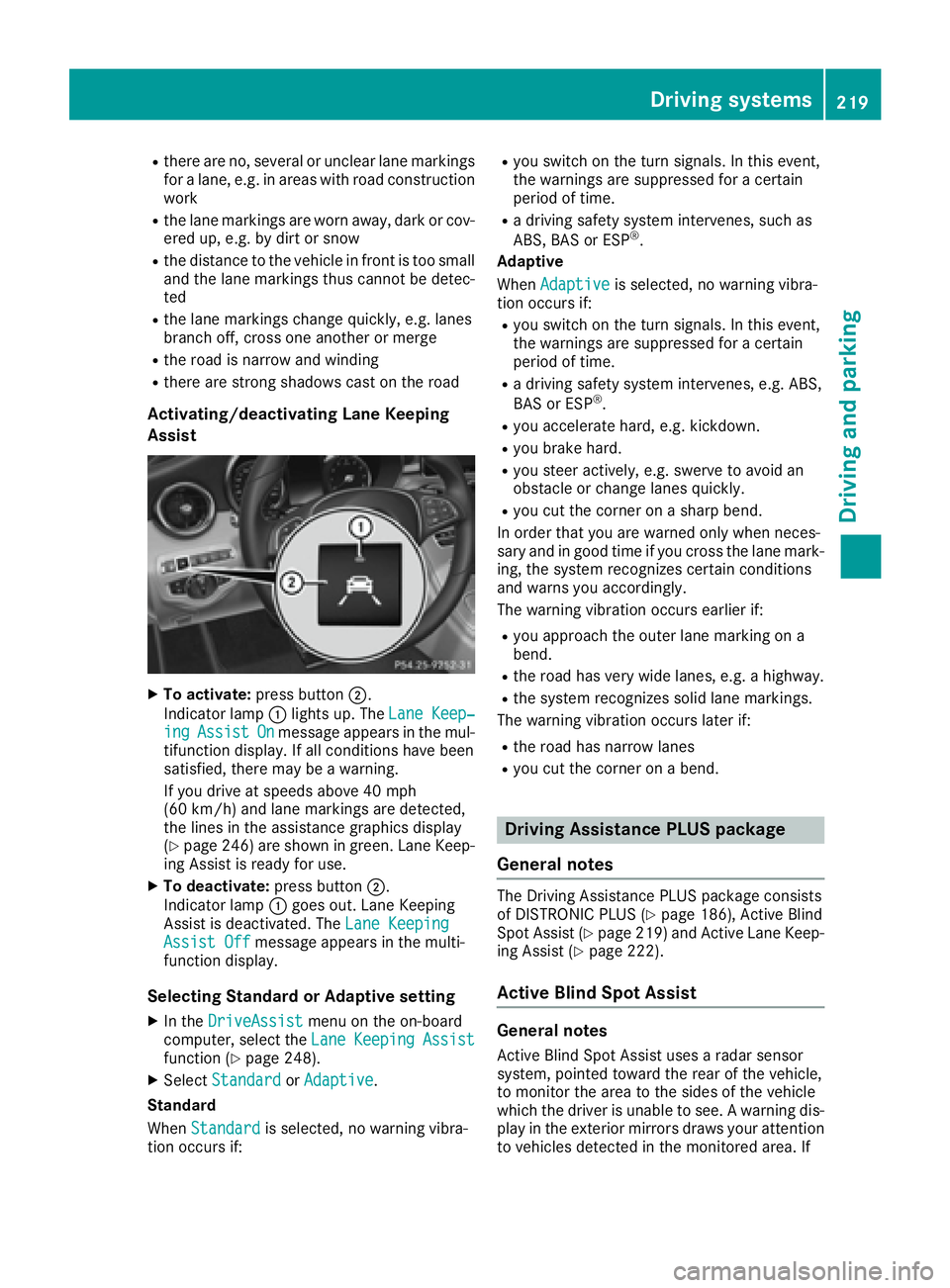
R
there are no, several or unclear lane markings
for a lane, e.g. in areas with road construction
work R
the lane markings are worn away, dark or cov-
ered up, e.g. by dirt or snow R
the distance to the vehicle in front is too small
and the lane markings thus cannot be detec-
ted R
the lane markings change quickly, e.g. lanes
branch off, cross one another or merge R
the road is narrow and winding R
there are strong shadows cast on the road
Activating/deactivating Lane Keeping
Assist
X
To activate: press button �D .
Indicator lamp �C lights up. The Lane Keep‐
ing Assist On message appears in the mul-
tifunction display. If all conditions have been
satisfied, there may be a warning.
If you drive at speeds above 40 mph
(60 km/h) and lane markings are detected,
the lines in the assistance graphics display
( Y
page 246) are shown in green. Lane Keep-
ing Assist is ready for use. X
To deactivate: press button �D .
Indicator lamp �C goes out. Lane Keeping
Assist is deactivated. The Lane Keeping
Assist Off message appears in the multi-
function display.
Selecting Standard or Adaptive setting X
In the DriveAssist menu on the on-board
computer, select the Lane Keeping Assist
function ( Y
page 248).X
Select Standard or Adaptive .
Standard
When Standard
is selected, no warning vibra-
tion occurs if: R
you switch on the turn signals. In this event,
the warnings are suppressed for a certain
period of time. R
a driving safety system intervenes, such as
ABS, BAS or ESP ®
.
Adaptive
When Adaptive is selected, no warning vibra-
tion occurs if: R
you switch on the turn signals. In this event,
the warnings are suppressed for a certain
period of time. R
a driving safety system intervenes, e.g. ABS,
BAS or ESP ®
. R
you accelerate hard, e.g. kickdown. R
you brake hard. R
you steer actively, e.g. swerve to avoid an
obstacle or change lanes quickly. R
you cut the corner on a sharp bend.
In order that you are warned only when neces-
sary and in good time if you cross the lane mark-
ing, the system recognizes certain conditions
and warns you accordingly.
The warning vibration occurs earlier if: R
you approach the outer lane marking on a
bend. R
the road has very wide lanes, e.g. a highway. R
the system recognizes solid lane markings.
The warning vibration occurs later if: R
the road has narrow lanes R
you cut the corner on a bend.
Driving Assistance PLUS package
General notes The Driving Assistance PLUS package consists
of DISTRONIC PLUS ( Y
page 186), Active Blind
Spot Assist ( Y
page 219 )a nd Active Lane Keep-
ing Assist ( Y
page 222).
Active Blind Spot Assist
General notes
Active Blind Spot Assist uses a radar sensor
system, pointed toward the rear of the vehicle,
to monitor the area to the sides of the vehicle
which the driver is unable to see. A warning dis-
play in the exterior mirrors draws your attention
to vehicles detected in the monitored area. IfDriving systems 219
Driving an d parking Z
Page 222 of 398
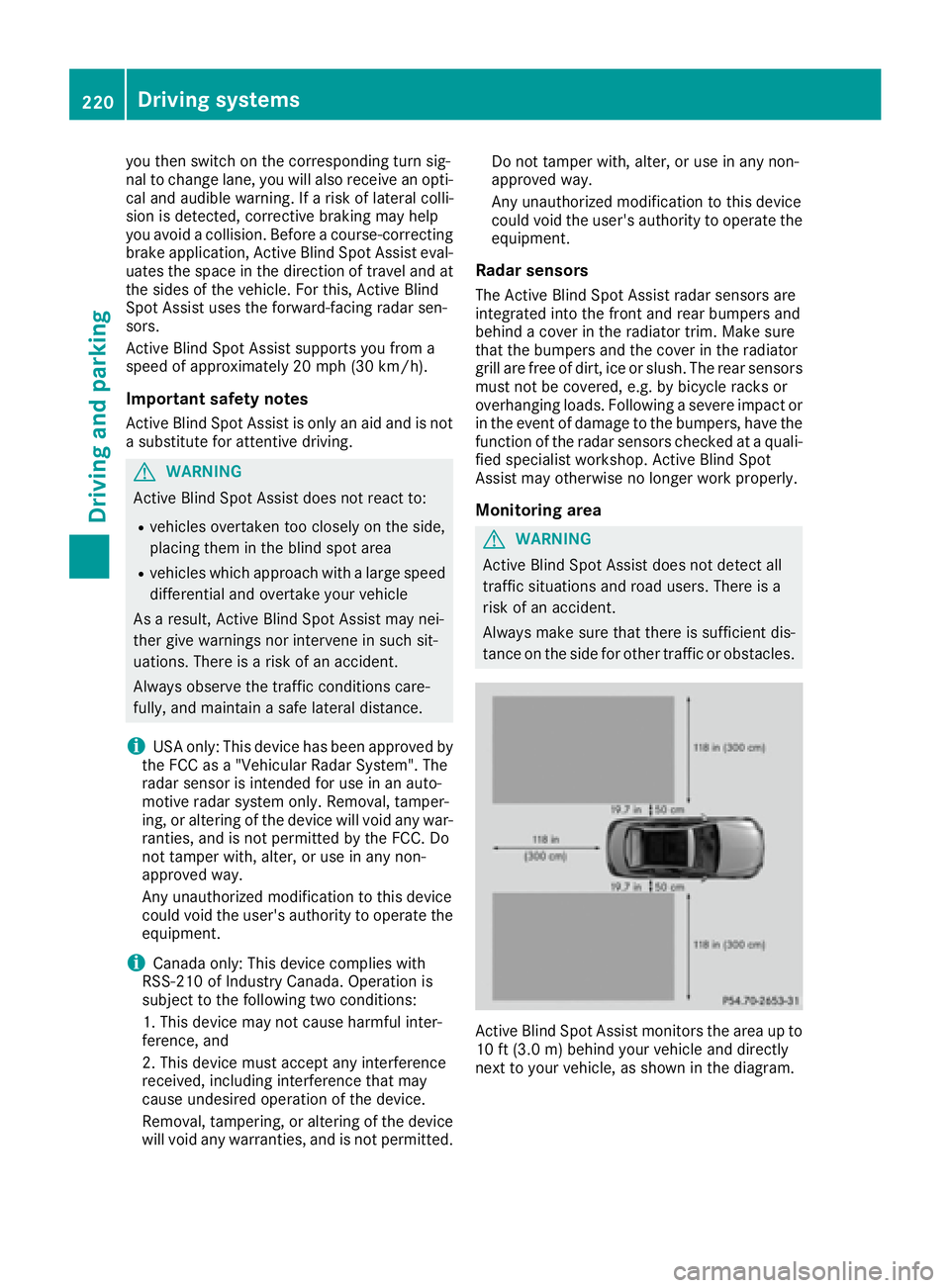
you then switch on th e correspondin g tur n sig-
nal to chang e lane, you will also receiv e an opti-
cal and audibl e warning. If a ris k of lateral colli-
sion is detected, corrective brakin g may help
you avoid a collision . Befor e a course-correcting
brak e application , Active Blind Spot Assis t eval -
uates th e spac e in th e direction of travel and at
th e side s of th e vehicle. Fo r this, Active Blind
Spot Assis t uses th e forward-facing rada r sen -
sors.
Active Blind Spot Assis t support s you from a
speed of approximately 20 mph (30 km/h).
Important safety notes Active Blind Spot Assis t is only an aid and is no t
a substitut e for attentive driving.
G WARNIN G
Active Blind Spot Assis t does no t reac t to :R
vehicles overtake n to o closely on th e side ,
placin g them in th e blin d spo t areaR
vehicles whic h approac h wit h a larg e speed
differential and overtake your vehicl e
As a result , Active Blind Spot Assis t may nei-
ther giv e warnings no r interven e in suc h sit -
uations. There is a ris k of an accident.
Always observ e th e traffic condition s care-
fully, and maintai n a saf e lateral distance.
i US A only: This device has been approve d by
th e FCC as a "Vehicular Radar System". The
rada r sensor is intended for use in an auto-
motive rada r system only. Removal, tamper -
ing, or altering of th e device will voi d any war-
ranties, and is no t permitte d by th e FCC. Do
no t tamper with, alter, or use in any non-
approve d way.
An y unauthorize d modification to this device
could voi d th e user's authorit y to operate th e
equipment.
i Canada only: This device complies wit h
RSS-210 of Industry Canada. Operation is
subjec t to th e followin g tw o conditions:
1. This device may no t caus e harmful inter-
ference , and
2. This device mus t accept any interferenc e
received, includin g interferenc e that may
caus e undesir ed o peration of th e d
evice .
Removal, tampering, or altering of th e device
will voi d any warranties, and is no t permitted. Do no t tamper with, alter, or use in any non-
approve d way.
An y unauthorize d modification to this device
could voi d th e user's authorit y to operate th e
equipment.
Rada r sensor sThe Active Blind Spot Assis t rada r sensor s are
integrate d into th e fron t and rear bumpers and
behind a cover in th e radiato r trim. Mak e sur e
that th e bumpers and th e cover in th e radiato r
grill are free of dirt, ice or slush. The rear sensor s
mus t no t be covered, e.g. by bicycle racks or
overhangin g loads . Following a severe impact or
in th e event of damage to th e bumpers , hav e th e
function of th e rada r sensor s checke d at a quali-
fie d specialist workshop . Active Blind Spot
Assis t may otherwise no longer wor k properly.
Monitoring area
G WARNIN G
Active Blind Spot Assis t does no t detec t all
traffic situation s and roa d users. There is a
ris k of an accident.
Always mak e sur e that there is sufficien t dis-
tance on th e side for other traffic or obstacles.
Active Blind Spot Assis t monitors th e area up to
10 ft (3. 0 m) behind your vehicl e and directl y
next to your vehicle, as shown in th e diagram.220
Driving systems
Driving and parking
Page 223 of 398
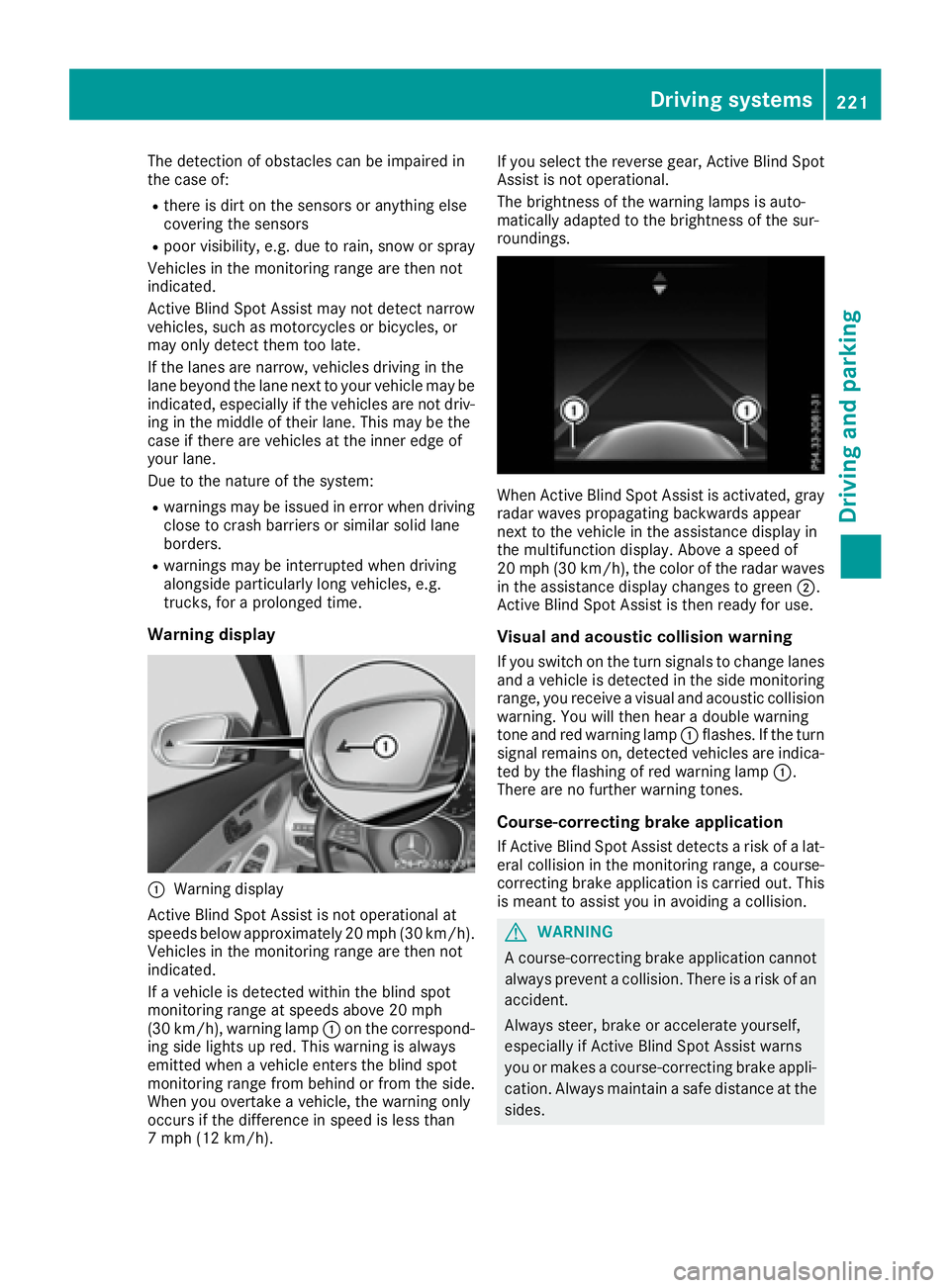
The detection of obstacles can be impaired in
the case of: R
there is dirt on the sensors or anything else
covering the sensors R
poor visibility, e.g. due to rain, snow or spray
Vehicles in the monitoring range are then not
indicated.
Active Blind Spot Assist may not detect narrow
vehicles, such as motorcycles or bicycles, or
may only detect them too late.
If the lanes are narrow, vehicles driving in the
lane beyond the lane next to your vehicle may be
indicated, especially if the vehicles are not driv-
ing in the middle of their lane. This may be the
case if there are vehicles at the inner edge of
your lane.
Due to the nature of the system: R
warnings may be issued in error when driving
close to crash barriers or similar solid lane
borders. R
warnings may be interrupted when driving
alongside particularly long vehicles, e.g.
trucks, for a prolonged time.
Warning display
�C
Warning display
Active Blind Spot Assist is not operational at
speeds below approximately 20 mph (30 km/h).
Vehicles in the monitoring range are then not
indicated.
If a vehicle is detected within the blind spot
monitoring range at speeds above 20 mph
(30 km/ h) , warning lamp �C on the correspond-
ing side lights up red. This warning is always
emitted when a vehicle enters the blind spot
monitoring range from behind or from the side.
When you overtake a vehicle, the warning only
occurs if the difference in speed is less than
7 mph (12 km/h). If you select the reverse gear, Active Blind Spot
Assist is not operational.
The brightness of the warning lamps is auto-
matically adapted to the brightness of the sur-
roundings.
When Active Blind Spot Assist is activated, gray
radar waves propagating backwards appear
next to the vehicle in the assistance display in
the multifunction display. Above a speed of
20 mph (30 km/h), the color of the radar waves
in the assistance display changes to green �D .
Active Blind Spot Assist is then ready for use.
Visual and acoustic collision warning If you switch on the turn signals to change lanes
and a vehicle is detected in the side monitoring
range, you receive a visual and acoustic collision
warning. You will then hear a double warning
tone and red warning lamp �C flashes. If the turn
signal remains on, detected vehicles are indica-
ted by the flashing of red warning lamp �C .
There are no further warning tones.
Course-correcting brake application
If Active Blind Spot Assist detects a risk of a lat-
eral collision in the monitoring range, a course-
correcting brake application is carried out. This
is meant to assist you in avoiding a collision.
G WARNING
A course-correcting brake application cannot
always prevent a collision. There is a risk of an
accident.
Always steer, brake or accelerate yourself,
especially if Active Blind Spot Assist warns
you or makes a course-correcting brake appli-
cation. Always maintain a safe distance at the
sides.Driving systems 221
Driving and parking Z
Page 224 of 398
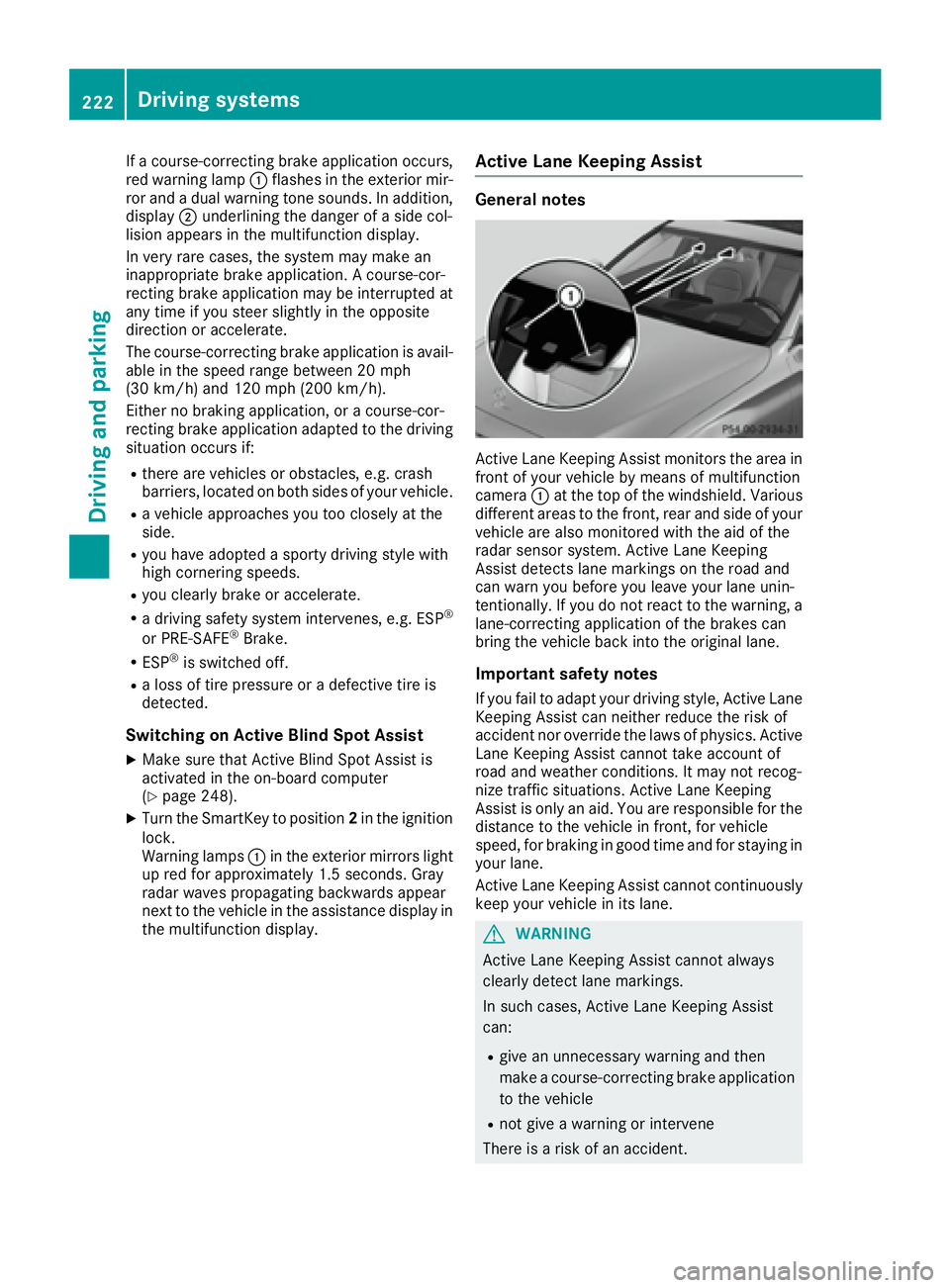
If a course-correcting brake application occurs,
red warning lamp �C flashes in the exterior mir-
ror and a dual warning tone sounds. In addition,
display �D underlining the danger of a side col-
lision appears in the multifunction display.
In very rare cases, the system may make an
inappropriate brake application. A course-cor-
recting brake application may be interrupted at
any time if you steer slightly in the opposite
direction or accelerate.
The course-correcting brake application is avail-
able in the speed range between 20 mph
(30 km/h) and 120 mph (200 km/h).
Either no braking application, or a course-cor-
recting brake application adapted to the driving
situation occurs if: R
there are vehicles or obstacles, e.g. crash
barriers, located on both sides of your vehicle. R
a vehicle approaches you too closely at the
side. R
you have adopted a sporty driving style with
high cornering speeds. R
you clearly brake or accelerate. R
a driving safety system intervenes, e.g. ESP ®
or PRE-SAFE ®
Brake.R
ESP ®
is switched off.R
a loss of tire pressure or a defective tire is
detected.
Switching on Active Blind Spot Assist X
Make sure that Active Blind Spot Assist is
activated in the on-board computer
( Y
page 248).X
Turn the SmartKey to position 2 in the ignition
lock.
Warning lamps �C in the exterior mirrors light
up red for approximately 1.5 seconds. Gray
radar waves propagating backwards appear
next to the vehicle in the assistance display in
the multifunction display. Active Lane Keeping Assist General notes
Active Lane Keeping Assist monitors the area in
front of your vehicle by means of multifunction
camera �C at the top of the windshield. Various
different areas to the front, rear and side of your
vehicle are also monitored with the aid of the
radar sensor system. Active Lane Keeping
Assist detects lane markings on the road and
can warn you before you leave your lane unin-
tentionally. If you do not react to the warning, a
lane-correcting application of the brakes can
bring the vehicle back into the original lane.
Important safety notes If you fail to adapt your driving style, Active Lane
Keeping Assist can neither reduce the risk of
accident nor override the laws of physics. Active
Lane Keeping Assist cannot take account of
road and weather conditions. It may not recog-
nize traffic situations. Active Lane Keeping
Assist is only an aid. You are responsible for the
distance to the vehicle in front, for vehicle
speed, for braking in good time and for staying in
your lane.
Active Lane Keeping Assist cannot continuously
keep your vehicle in its lane.
G WARNING
Active Lane Keeping Assist cannot always
clearly detect lane markings.
In such cases, Active Lane Keeping Assist
can: R
give an unnecessary warning and then
make a course-correcting brake application
to the vehicle R
not give a warning or intervene
There is a risk of an accident.222
Driving systems
Driving and parking
Page 225 of 398
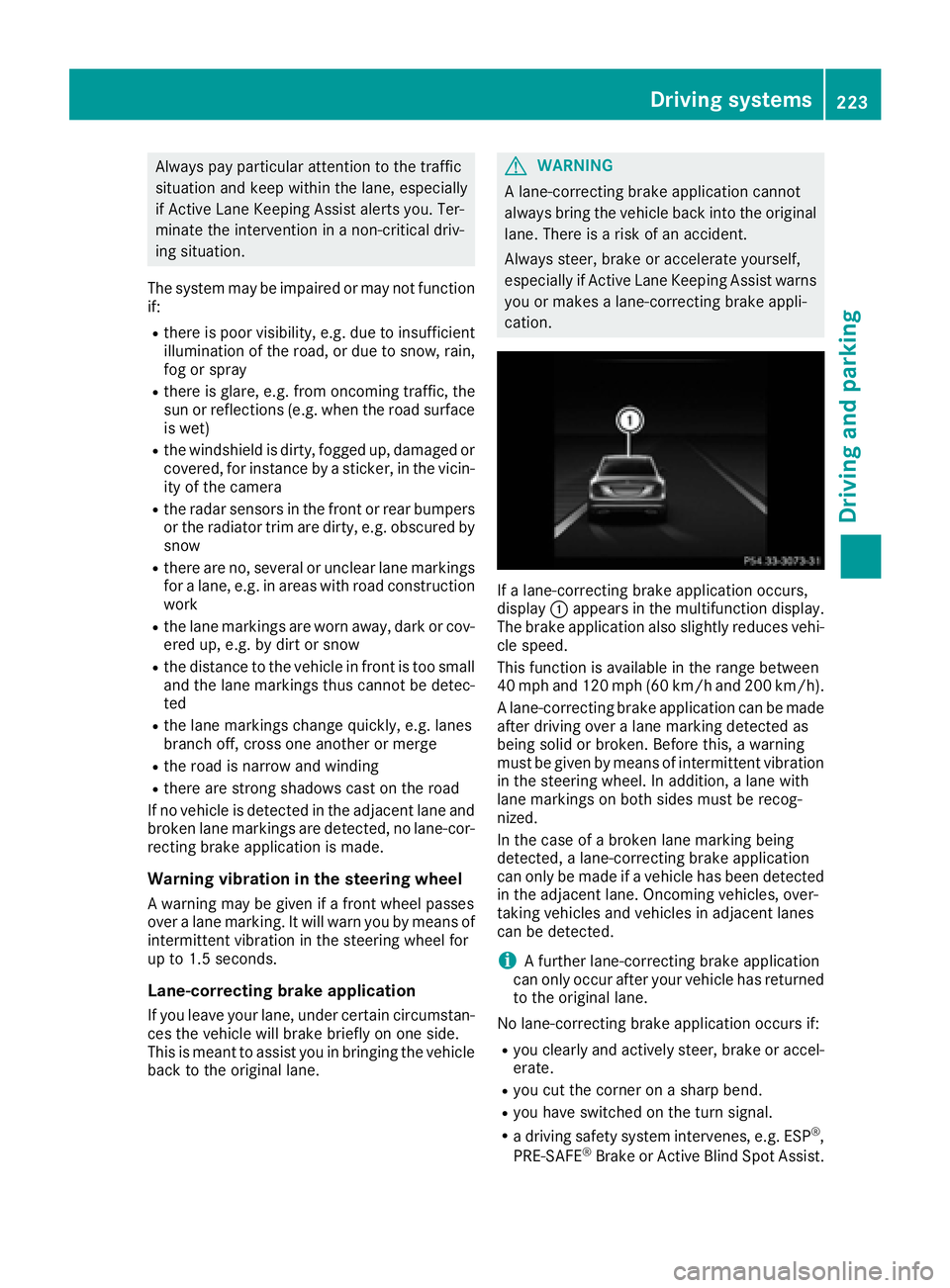
Always pay particular attention to the traffic
situation and keep within the lane, especially
if Active Lane Keeping Assist alerts you. Ter-
minate the intervention in a non-critical driv-
ing situation.
The system may be impaired or may not function
if: R
there is poor visibility, e.g. due to insufficient
illumination of the road, or due to snow, rain,
fog or spray R
there is glare, e.g. from oncoming traffic, the
sun or reflections (e.g. when the road surface
is wet) R
the windshield is dirty, fogged up, damaged or
covered, for instance by a sticker, in the vicin-
ity of the camera R
the radar sensors in the front or rear bumpers
or the radiator trim are dirty, e.g. obscured by
snow R
there are no, several or unclear lane markings
for a lane, e.g. in areas with road construction
work R
the lane markings are worn away, dark or cov-
ered up, e.g. by dirt or snow R
the distance to the vehicle in front is too small
and the lane markings thus cannot be detec-
ted R
the lane markings change quickly, e.g. lanes
branch off, cross one another or merge R
the road is narrow and winding R
there are strong shadows cast on the road
If no vehicle is detected in the adjacent lane and
broke n lane markings are detected, no lane-cor-
re
cting brake application is made.
Warning vibration in the steering wheel
A warning may be given if a front wheel passes
over a lane marking. It will warn you by means of
intermittent vibration in the steering wheel for
up to 1.5 second s.
Lane -correcting brake application
If you leave your lane, under certain circumstan-
ces the vehicle will brake briefly on one side.
This is meant to assist you in bringing the vehicle
back to the original lane. G WARNING
A lane-correcting brake application cannot
always bring the vehicle back into the original
lane. There is a risk of an accident.
Always steer, brake or accelerate yourself,
especially if Active Lane Keeping Assist warns
you or makes a lane-correcting brake appli-
cation.
If a lane-correcting brake application occurs,
display �C appears in the multifunction display.
The brake application also slightly reduces vehi-
cle speed.
This function is available in the range between
40 mph and 120 mph (60 km/h and 200 km/h).
A lane-correcting brake application can be made
after driving over a lane marking detected as
being solid or broken. Before this, a warning
must be given by means of intermittent vibration
in the steering wheel. In addition, a lane with
lane markings on both sides must be recog-
nized.
In the case of a broken lane marking being
detected, a lane-correcting brake application
can only be made if a vehicle has been detected
in the adjacent lane. Oncoming vehicles, over-
taking vehicles and vehicles in adjacent lanes
can be detected.
i A further lane-correcting brake application
can only occur after your vehicle has returned
to the original lane.
No lane-correcting brake application occurs if: R
you clearly and actively steer, brake or accel-
erate. R
you cut the corner on a sharp bend. R
you have switched on the turn signal. R
a driving safety system intervenes, e.g. ESP ®
,
PRE-SAFE ®
Brake or Active Blind Spot Assist.Driving systems 223
Driving and parking Z
Page 226 of 398
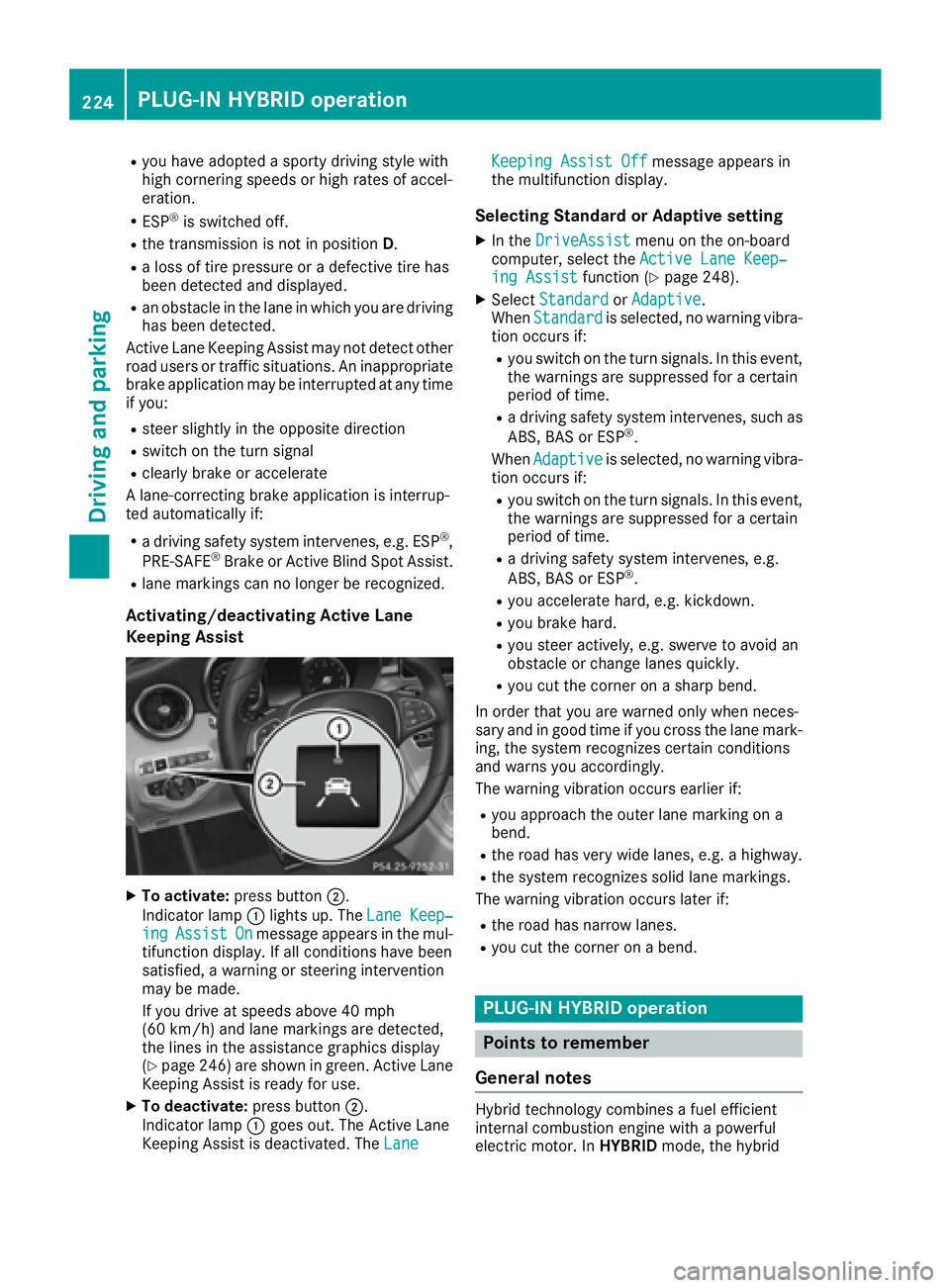
R
you hav e adopte d a sport y drivin g style wit h
high cornering speeds or high rates of accel-
eration .R
ES P ®
is switched off .R
th e transmission is no t in position D .R
a loss of tire pressur e or a defective tire has
been detecte d and displayed.R
an obstacle in th e lan e in whic h you are drivin g
has been detected.
Active Lan e Keepin g Assis t may no t detec t other
roa d user s or traffic situations. An inappropriat e
brak e application may be interrupted at any time
if you: R
steer slightly in th e opposit e directionR
switch on th e tur n signalR
clearly brak e or accelerate
A lane-correcting brak e application is interrup-
te d automatically if: R
a drivin g safet y system intervenes, e.g. ES P ®
,
PRE-SAF E ®
Brake or Active Blind Spot Assist.R
lan e marking s can no longer be recognized.
Activating/deactivating Active Lan e
Keeping Assis t
X
To activate: press butto n �D .
Indicato r lamp �C lights up. The Lan e Keep‐
ing Assist On message appears in th e mul-
tifunction display. If all condition s hav e been
satisfied, a warnin g or steerin g intervention
may be made .
If you drive at speeds abov e 40 mph
(60 km/h) and lan e marking s are detected,
th e lines in th e assistanc e graphic s display
( Y
page 246) are shown in green . Active Lan e
Keepin g Assis t is read y for use.X
To deactivate: press butto n �D .
Indicato r lamp �C goe s out . The Active Lan e
Keepin g Assis t is deactivated. The Lan e Keepin g Assist Off message appears in
th e multifunction display.
Selecting Standar d or Adaptive setting X
In th e DriveAssist men u on th e on-boar d
computer, select th e Active Lan e Keep‐
ing Assist function ( Y
page 248).X
Selec t Standard or Adaptive .
Whe n Standard is selected, no warnin g vibra-
tion occur s if: R
you switch on th e tur n signals. In this event ,
th e warnings are suppressed for a certain
period of time. R
a drivin g safet y system intervenes, suc h as
ABS, BA S or ES P ®
.
Whe n Adaptive
is selected, no warnin g vibra-
tion occur s if: R
you switch on th e tur n signals. In this event ,
th e warnings are suppressed for a certain
period of time. R
a drivin g safet y system intervenes, e.g.
ABS, BA S or ES P ®
.R
you accelerate hard, e.g. kickdown .R
you brak e hard. R
you steer actively, e.g. swerve to avoid an
obstacle or chang e lanes quickly.R
you cut th e corner on a shar p bend.
In order that you are warned only when neces-
sar y and in goo d time if you cross th e lan e mark-
ing, th e system recognizes certain condition s
and warn s you accordingly.
The warnin g vibration occur s earlier if:R
you approac h th e outer lan e marking on a
bend. R
th e roa d has ver y wide lanes, e.g. a highway.R
th e system recognizes soli d lan e markings.
The warnin g vibration occur s later if:R
th e roa d has narrow lanes. R
you cut th e corner on a bend.
PLUG ‑ IN HYBRID operation
Points to rememb er
Gene ra l notes
Hybrid technology combine s a fuel efficien t
internal combustion engin e wit h a powerful
electric motor. In HYBRID mode, th e hybrid224
PLUG ‑ IN HYBRID operation
Driving and parking
Page 227 of 398
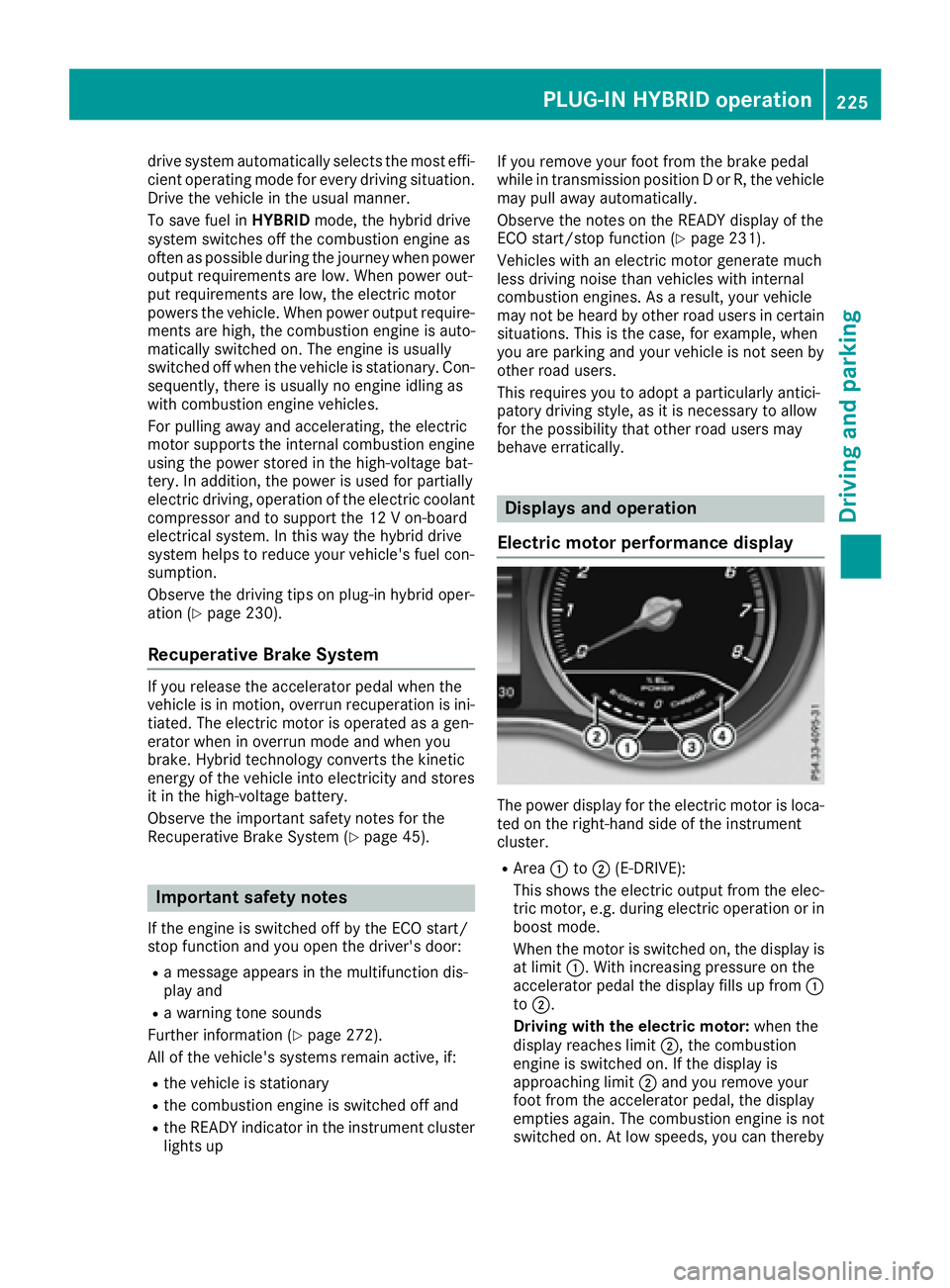
drive system automatically selects the most effi-
cient operating mode for every driving situation.
Drive the vehicle in the usual manner.
To save fuel in HYBRID mode, the hybrid drive
system switches off the combustion engine as
often as possible during the journey when power
output requirements are low. When power out-
put requirements are low, the electric motor
powers the vehicle. When power output require-
ments are high, the combustion engine is auto-
matically switched on. The engine is usually
switched off when the vehicle is stationary. Con-
sequently, there is usually no engine idling as
with combustion engine vehicles.
For pulling away and accelerating, the electric
motor supports the internal combustion engine
using the power stored in the high-voltage bat-
tery. In addition, the power is used for partially
electric driving, operation of the electric coolant
compressor and to support the 12 V on-board
electrical system. In this way the hybrid drive
system helps to reduce your vehicle's fuel con-
sumption.
Observe the driving tips on plug-in hybrid oper-
ation ( Y
page 230).
Recuperative Brake System If you release the accelerator pedal when the
vehicle is in motion, overrun recuperation is ini-
tiated. The electric motor is operated as a gen-
erator when in overrun mode and when you
brake. Hybrid technology converts the kinetic
energy of the vehicle into electricity and stores
it in the high-voltage battery.
Observe the important safety notes for the
Recuperative Brake System ( Y
page 45).
Important safety notes If the engine is switched off by the ECO start/
stop function and you open the driver's door: R
a message appears in the multifunction dis-
play and R
a warning tone sounds
Further information ( Y
page 272).
All of the vehicle's systems remain active, if: R
the vehicle is stationary R
the combustion engine is switched off and R
the READY indicator in the instrument cluster
lights up If you remove your foot from the brake pedal
while in transmission position D or R, the vehicle
may pull away automatically.
Observe the notes on the READY display of the
ECO start/stop function ( Y
page 231).
Vehicles with an electric motor generate much
less driving noise than vehicles with internal
combustion engines. As a result, your vehicle
may not be heard by other road users in certain
situations. This is the case, for example, when
you are parking and your vehicle is not seen by
other road users.
This requires you to adopt a particularly antici-
patory driving style, as it is necessary to allow
for the possibility that other road users may
behave erratically.
Displays and operation
Electric motor performance display
The power display for the electric motor is loca-
ted on the right-hand side of the instrument
cluster. R
Area �C to �D (E-DRIVE):
This shows the electric output from the elec-
tric motor, e.g. during electric operation or in
boost mode.
When the motor is switched on, the display is
at limit �C . With increasing pressure on the
accelerator pedal the display fills up from �C
to �D .
Driving with the electric motor: when the
display reaches limit �D , the combustion
engine is switched on. If the display is
approaching limit �D and you remove your
foot from the accelerator pedal, the display
empties again. The combustion engine is not
switched on. At low speeds, you can therebyPLUG ‑ IN HYBRID operation 225
Driving and parking Z
Page 228 of 398
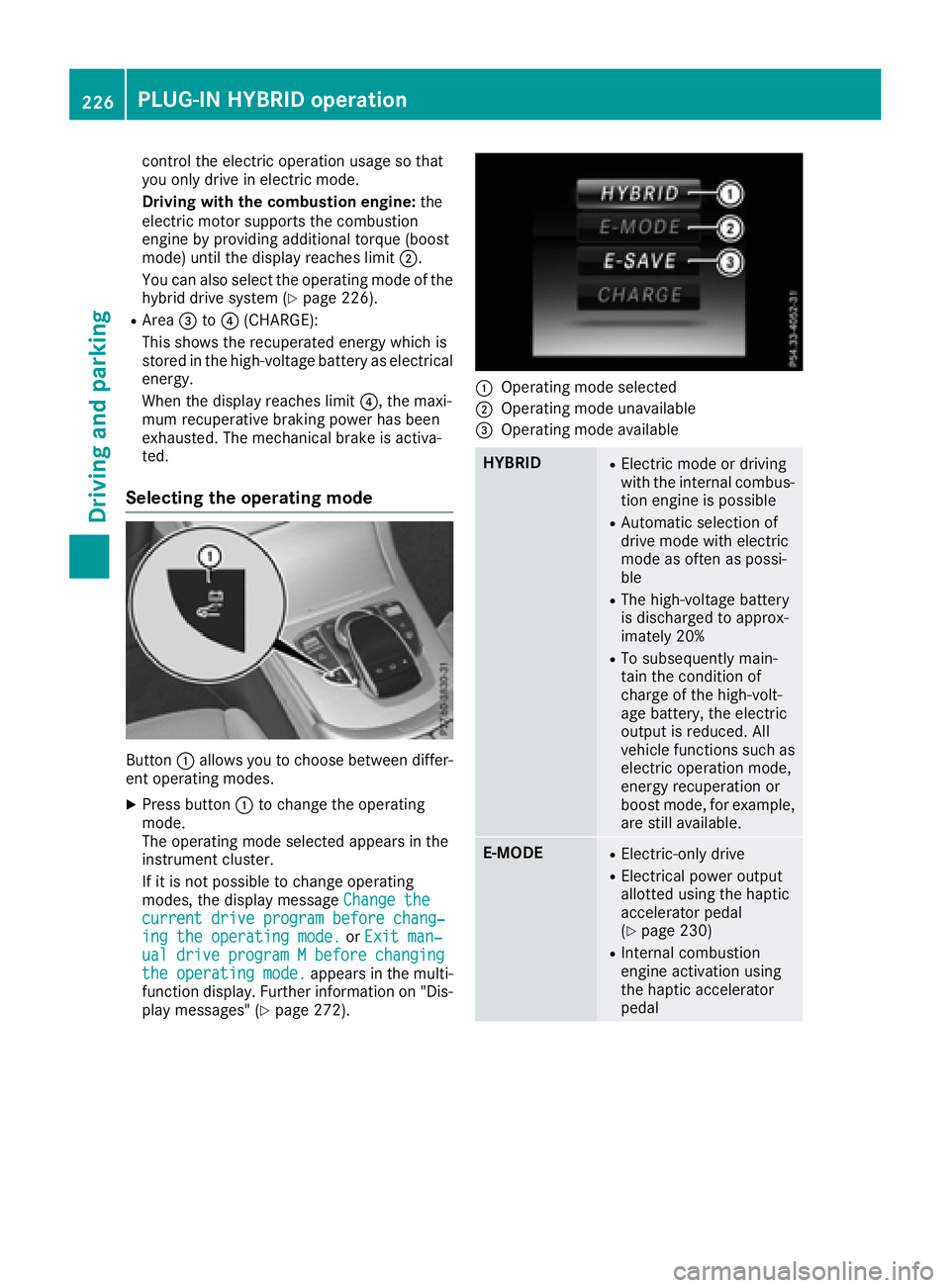
control the electric operation usage so that
you only drive in electric mode.
Driving with the combustion engine: the
electric motor supports the combustion
engine by providing additional torque (boost
mode) until the display reaches limit �D .
You can also select the operating mode of the
hybrid drive system ( Y
page 226).R
Area �
Page 229 of 398
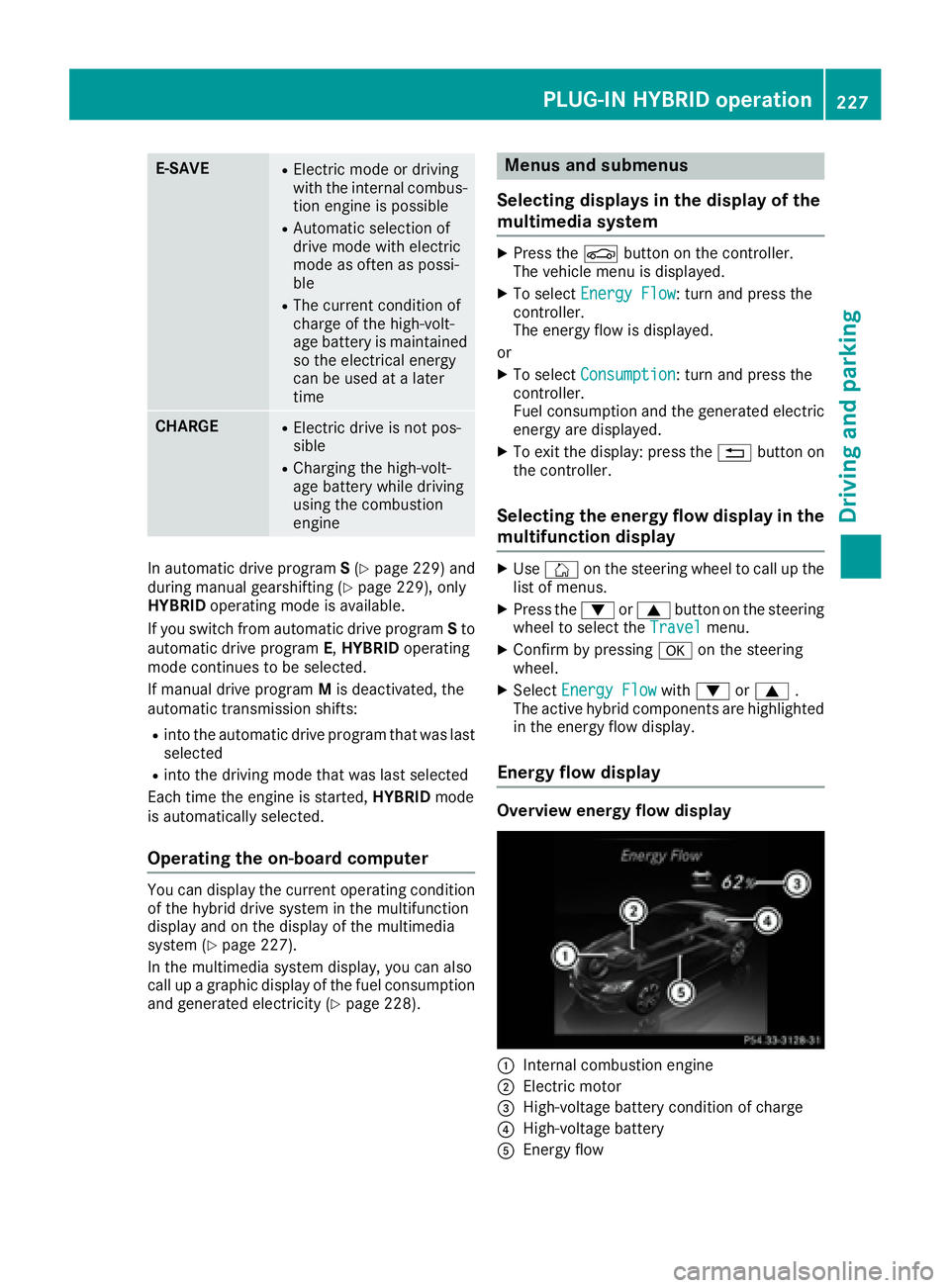
E-SAVE R
Electric mode or driving
with the internal combus-
tion engine is possible R
Automatic selection of
drive mode with electric
mode as often as possi-
ble R
The current condition of
charge of the high-volt-
age battery is maintained
so the electrical energy
can be used at a later
time
CHARGE R
Electric drive is not pos-
sible R
Charging the high-volt-
age battery while driving
using the combustion
engine
In automatic drive program S ( Y
page 229) and
during manual gearshifting ( Y
page 229), only
HYBRID operating mode is available.
If you switch from automatic drive program S to
automatic drive program E , HYBRID operating
mode continues to be selected.
If manual drive program M is deactivated, the
automatic transmission shifts: R
into the automatic drive program that was last
selected R
into the driving mode that was last selected
Each time the engine is started, HYBRID mode
is automatically selected.
Operating the on-board computer You can display the current operating condition
of the hybrid drive system in the multifunction
display and on the display of the multimedia
system ( Y
page 227).
In the multimedia system display, you can also
call up a graphic display of the fuel consumption
and generated electricity ( Y
page 228). Menus and submenus
Selecting displays in the display of the
multimedia system X
Press the �
Page 230 of 398
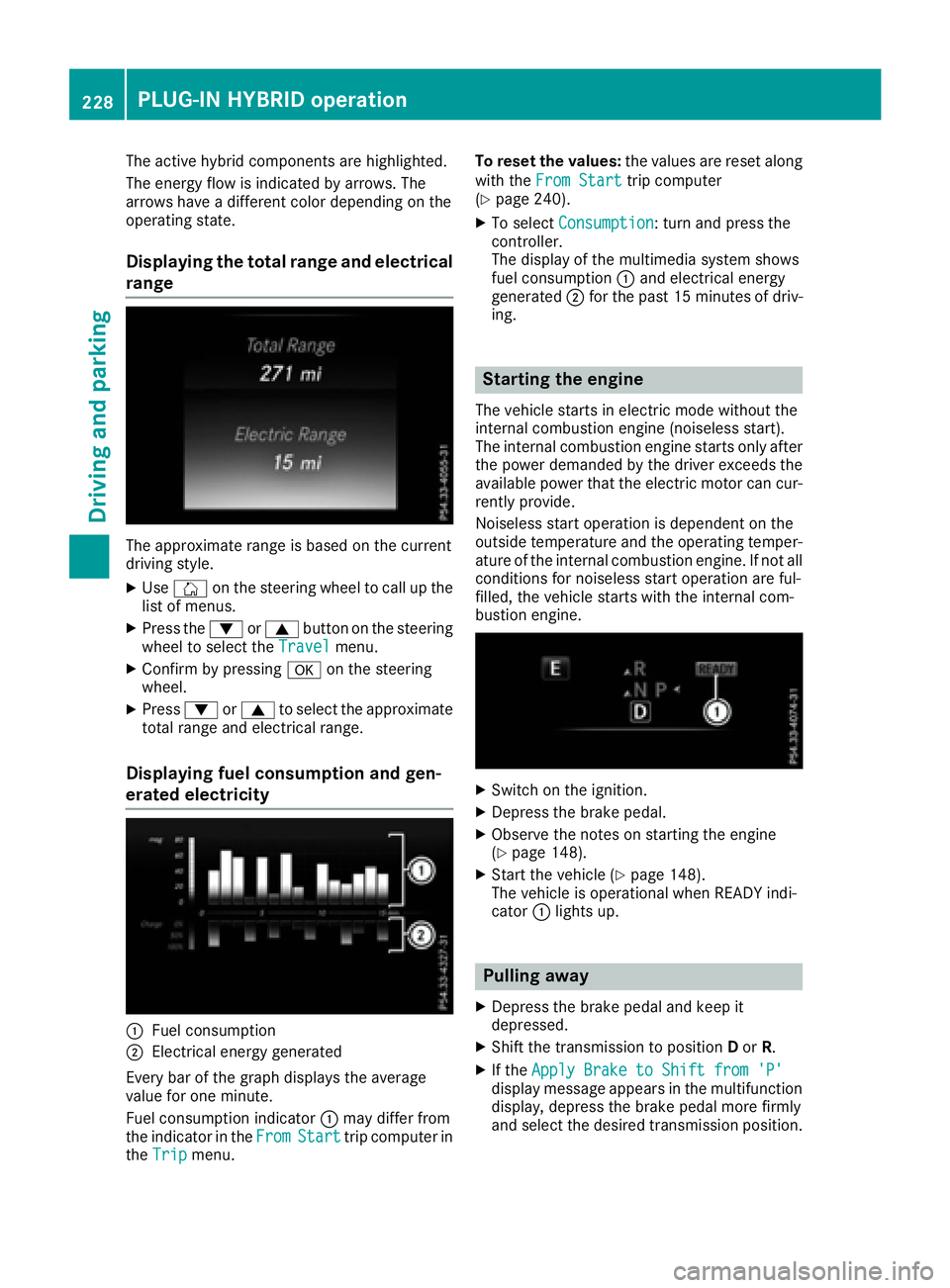
The active hybrid components are highlighted.
The energy flow is indicated by arrows. The
arrows have a different color depending on the
operating state.
Displaying the total range and electrical
range
The approximate range is based on the current
driving style. X
Use �